I have a terrible cold. When one is sniffling and snuffling and generally feeling lousy, there’s nothing more comforting than a nice handkerchief, of which, it occurred to me this morning, I possess quite a few. So I took some photographs of the ones that aren’t in use or in the wash.
Some of them are gifts . . .
. . .and my sister bought this one for me, probably when the Horrocks exhibition was on at the V&A.
I have acquired the majority of my hankies very cheaply in charity shops and on eBay. I find their workaday machine embroidery very pleasing. . .
. . . and some were once bought in other countries . . .
(I have actually visited Lugano, which made this one a rather nice find)
For some reason this one is my favourite for actual nose blowing: I like its 1960s brown; its tesselated design, and it also has a really high thread count, which makes it very soft.
I have a few nice examples where the corners are edged with lace
and of course, I have also acquired a few that are just too nice to use. This one is an interesting combination of drawn-thread work with machine embroidery.
This one is very fine indeed . . .
. . . it has been torn, and rather inexpertly mended.
This lovely example of whitework and drawn thread work is the oldest handkerchief I own.
. . . but the simple motifs and lines of this example make it my confirmed favourite.
It occurred to me that the simple square of fabric that goes under the name of handkerchief has a long history as an everyday object, with many different meanings, and many different uses. Handkerchiefs are multiply functional and decorative: not merely for mopping watery eyes and noses, carelessly dropped or ardently retrieved they might act as symbols of romantic attachment and desire. Handkerchiefs are intimate and personal objects, and as such, might be means of connecting a wearing-body to a sense of place: as a souvenir, a handkerchief might be a tiny repository of memory and personal connection, or, unfolded from the pocket of an eighteenth-century lady or a twentieth-century airman, might disclose a sneakily concealed map of unfamiliar territory. As furoshiki they are a means of wrapping and transporting food or gifts, and they can be worn about the person in a multitude of ways. I imagine the head-scarf / kerchief springs immediately to mind. . .
. . . but, when considering a kerchief as a garment, my first thought was of this portrait of Frances Burney.

Frances Burney by Edward Burney (1780). National Portrait Gallery.
Kerchiefs — a length or folded triangle of fabric that covered neck and bosom providing warmth, coverage, and decoration — were a familiar staple of eighteenth-century women’s dress. Oddly, this meaning of kerchief does not appear in Cumming and Cunnington’s Dictionary of Fashion History, and receives only passing mention in the OED. If you’ve read as many eighteenth-century letters and novels as I have you would find this omission curious . . . but the issue is probably merely one of shifting nomenclature as well as fashion. Kerchiefs in the 1780s grew ever more voluminous and diaphanous . . .
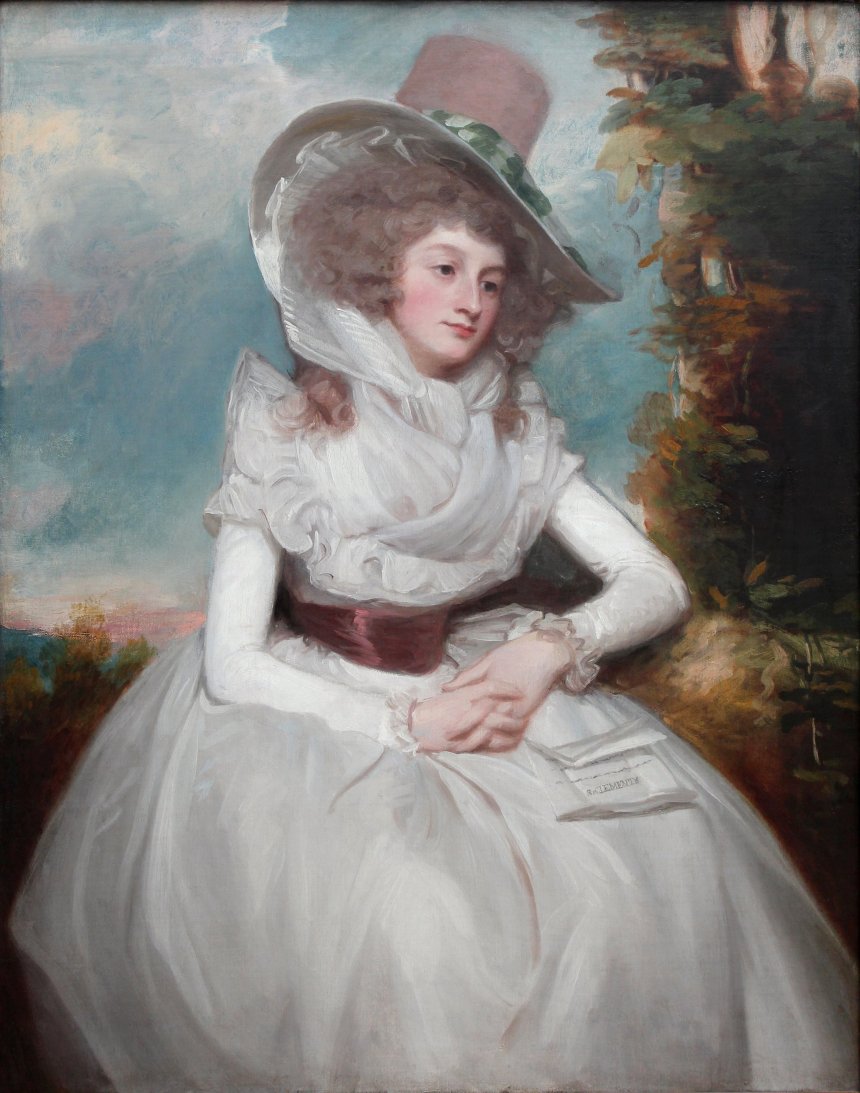
George Romney, portrait of Catherine Clemens, 1788.
. . . and by the early 19th century these garments were referred to not as a homely English kerchief but as a carelessly elaborate French fichu

Late eighteenth-century American kerchief / fichu in the collections of the Metropolitan Museum of Art.
Well, I have come some way from where I began with my own kerchiefs, which is to say that putting this post together has, for an hour or so, successfully distracted me from the realities of my cold.
PS: thanks for your good wishes: my first driving lesson was OK: despite much swearing and occasional kerb-mounting, according to my instructor I was “no too bad”. I hope to be back behind the wheel as soon as I’ve stopped sneezing.

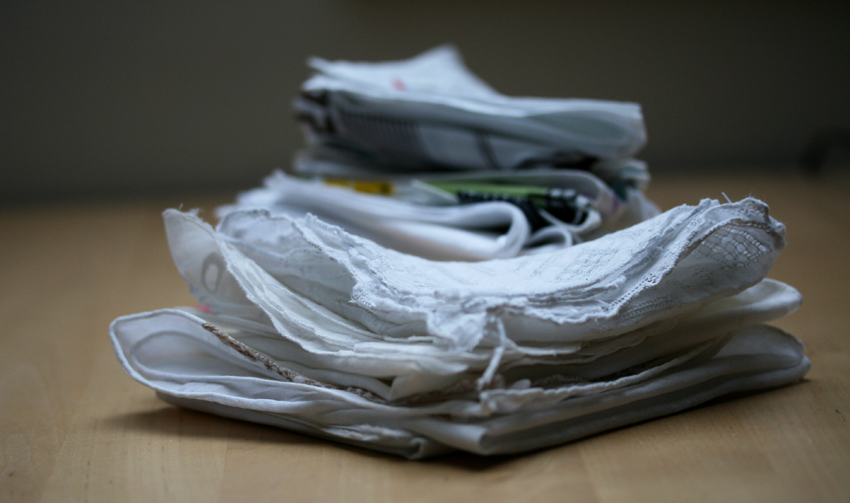

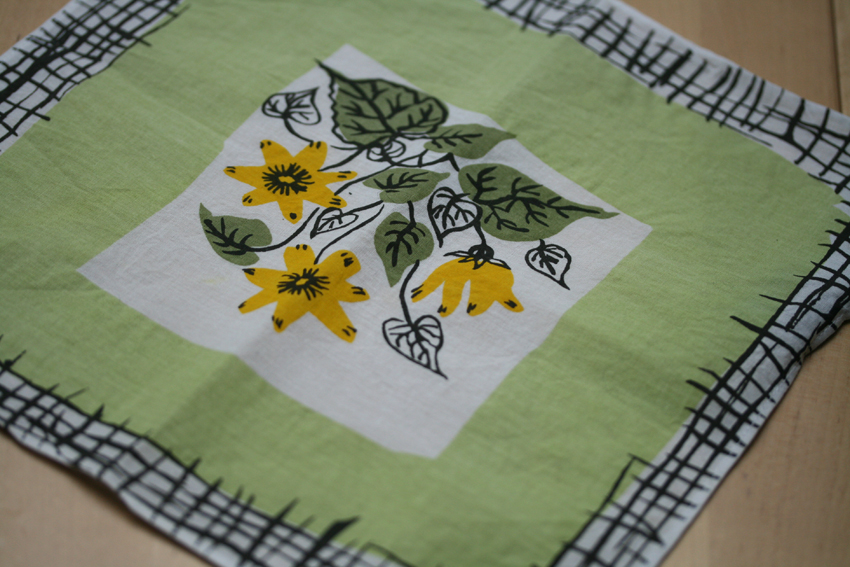
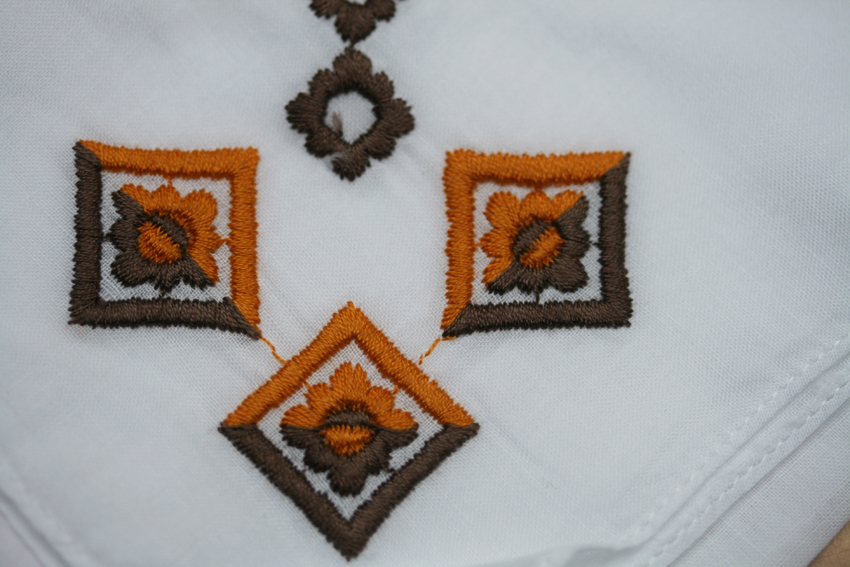
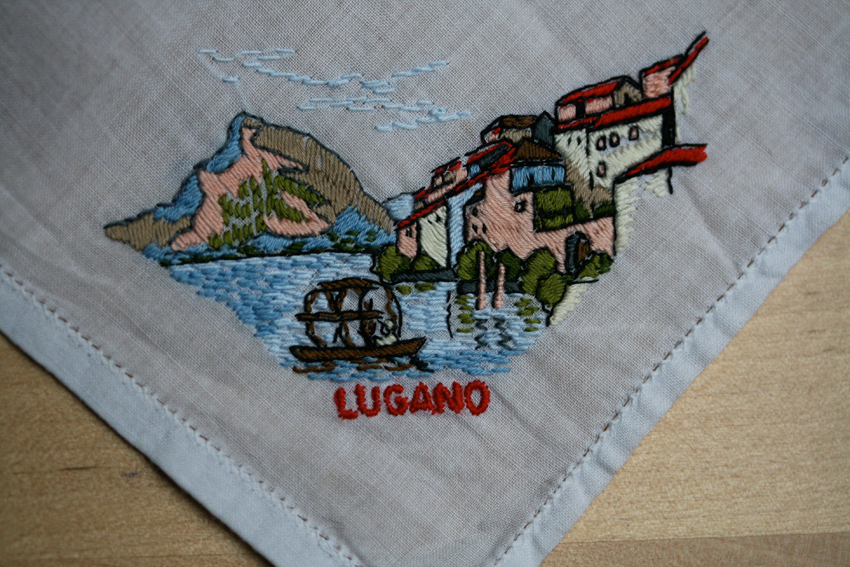
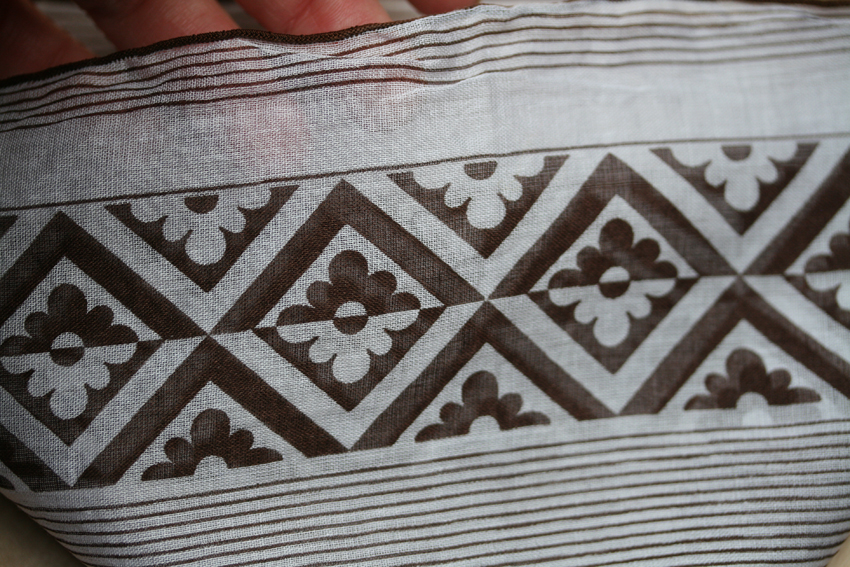
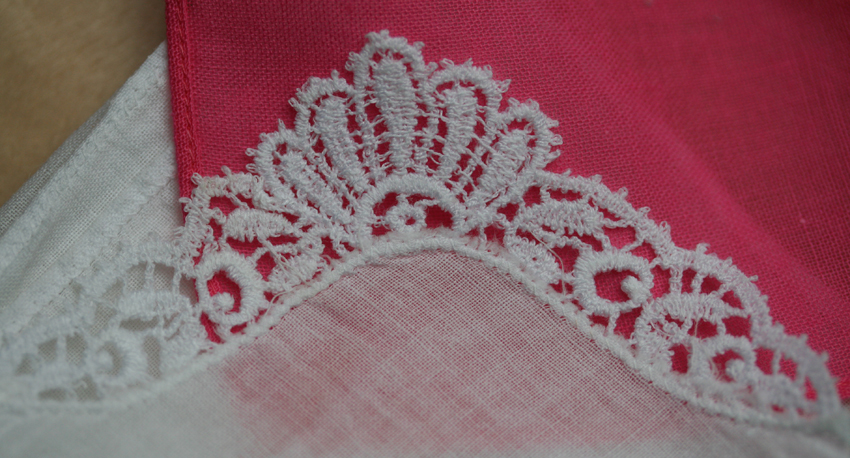
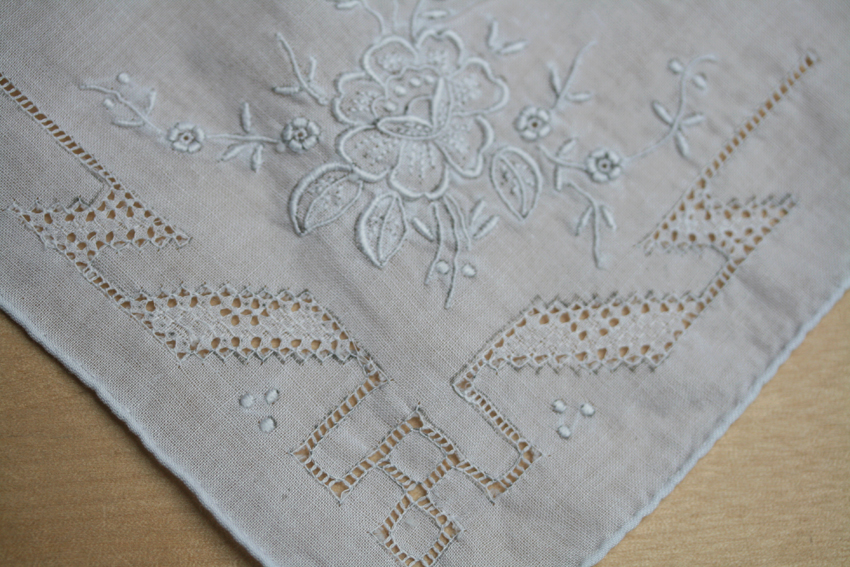
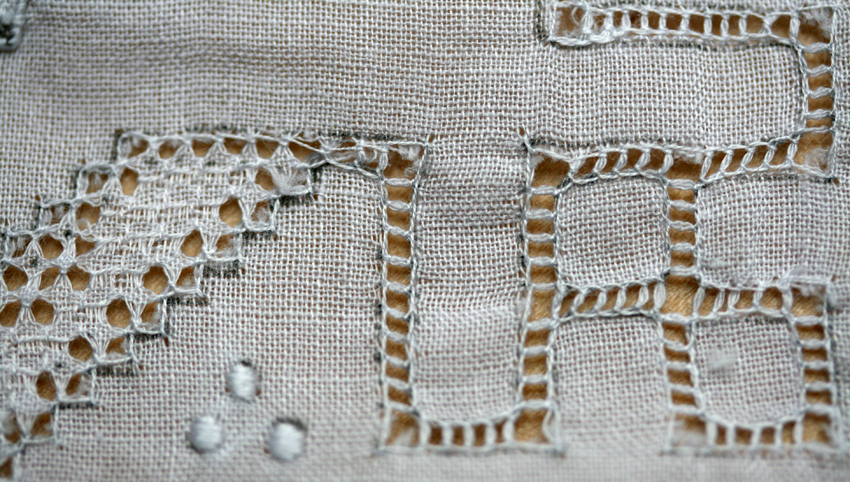

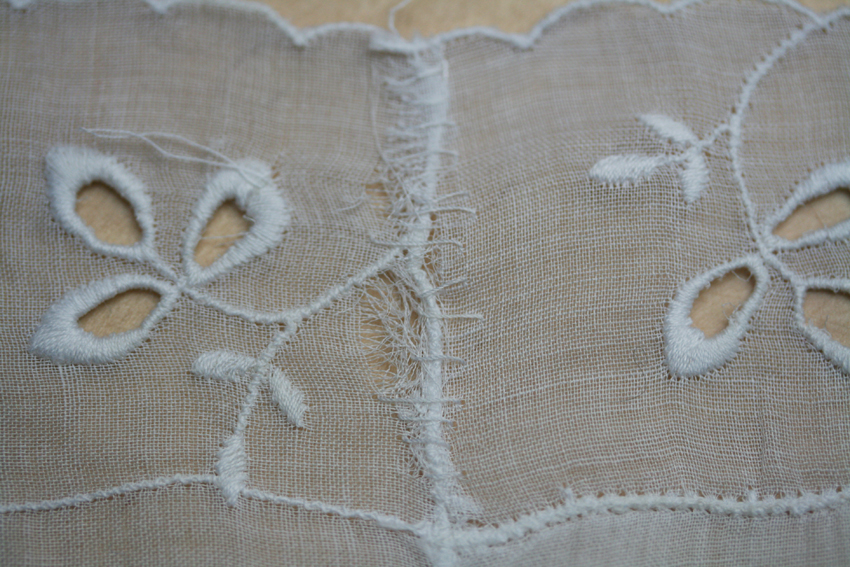
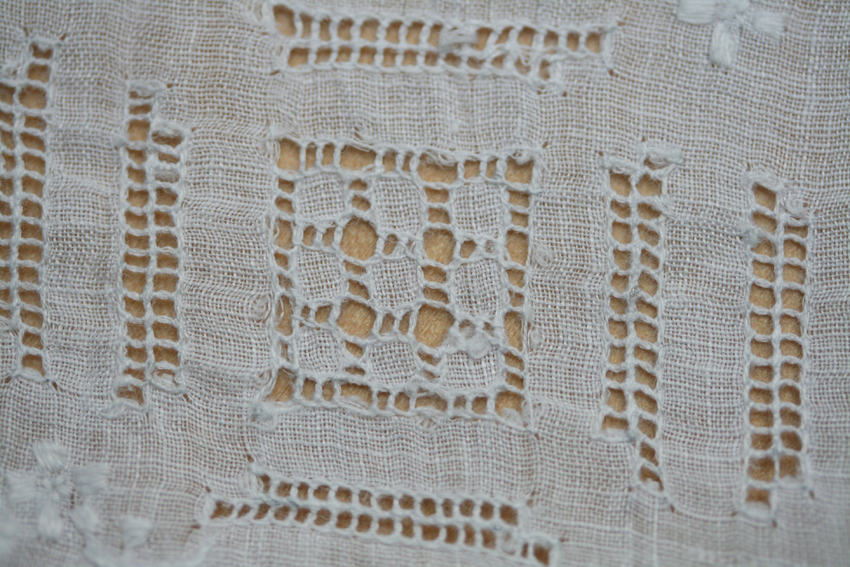
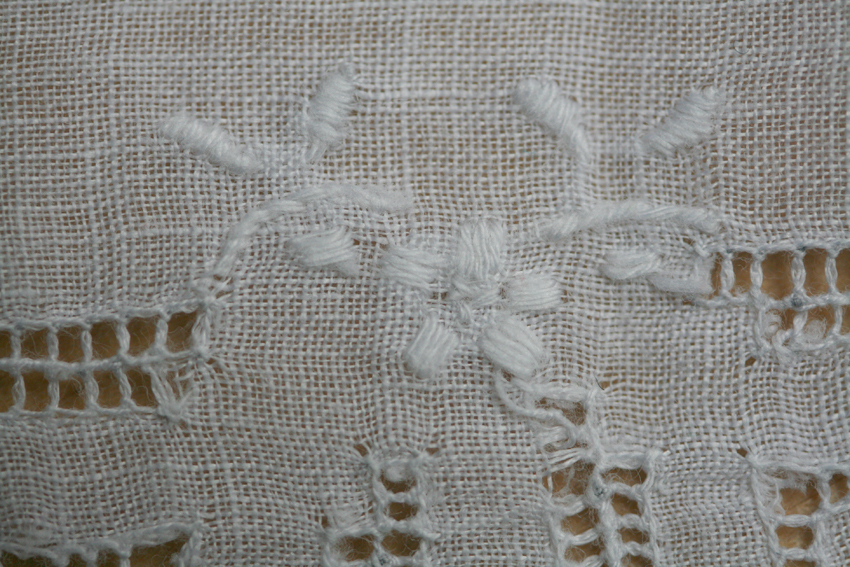

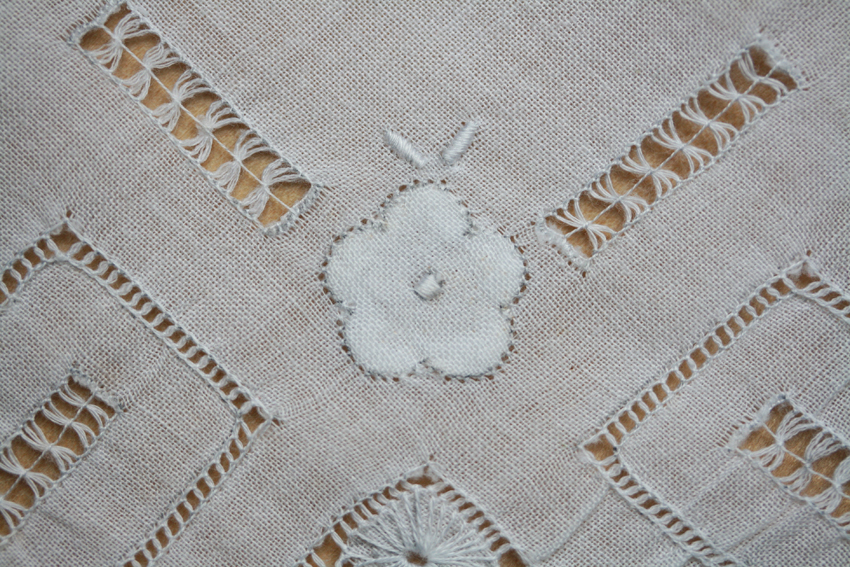

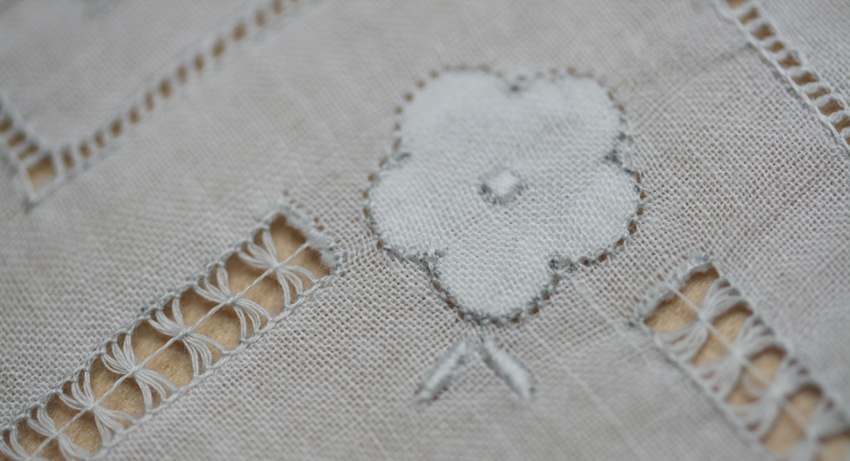
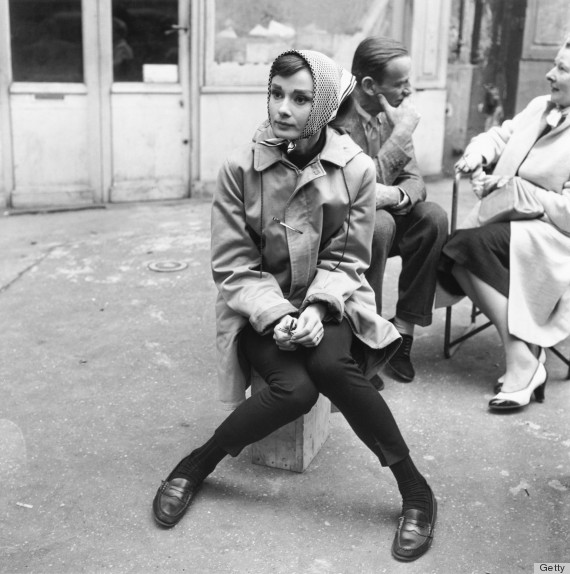
I adore your piece on hankerchiefs, and i will tell you why…I started falling in love with them in my young life (around age 20) when I was handed a beautiful white kerchief trimmed in lilac threads with tiny flowers on my wedding day from my great-grandmother. I still own it today, even after 17 years of marriage and the divorce.
But, today, at age 41. I have began to hit gargae sales, estate sales and just small town boutiques and Ihave found myself searching for them. The boutique ones I admire, but never purchase. The estate sale ones are my hearts favorite. I often wonder what the hankerchief was for. Was it ourchased for a wedding, was it given as a gift, and if so, by who? Was it a family member? Maybe a secret lover? Was it hand-made. Was it store bought? Was it designed special for them?
I love and cherish the stories I know behind them and stories I long to know for those bought from sommeone we have lost.
I do enjoy my hankerchiefs, my father always to this day at the age of 70, carries one. He always said “with y wife and three daughters, soeone is bound to sheda tear soewhere, and when they do, my hankerchief and I will be here for them”.
After my divorce, when Iwas finally ready to start dating, I went out with a gentleman and a few weeks later we were at an event which caused me to become emotional, and there he was, by y side, holding out his hankerchief for me. It ws then I knew, he was the one.
He never knew about my love for them or the love I had for my Fathers hankerchiefs. Over the years they have become a security blanket for my family, a beautiful time-honored tradition that will never go away.
Enjoy your kerciefs my dear friend, the lacey, the simple, the colorful and especially the ones whos story you don’t know.
LikeLike
Sweet!
LikeLike
Loved your account, Audrey. What a marvelous collection, so full of memories, you must have.
LikeLike
Very lovely collection.
LikeLike
Reminds me of my Nana. Maybe she knew best.
LikeLike
What a romantic notion to wonder the significance and purpose a handkerchief had in the past to someone. That is why I love antiques but for some reason I do gravitate towards handkerchiefs and vintage gloves. Nice pics!
LikeLike
They look too pretty to blow your nose on. I have several embroidered ones from Grandma. A nice post and pics.
LikeLike
Cloth handkerchiefs aren’t popular any more. If you use yours how do you wash them? I’d like to kick the tissue habit?
LikeLike
Having always used cloth hankies on a daily basis, I have to say I am very surprised by some of these comments! I tend to wash the really ‘nice’ ones by hand, and pop the others in the machine. If I have a cold, I make sure I wash them separately from everything else. The fabric improves with washing, is softer on your nose, and generally much better for the environment as one isn’t purchasing and discarding masses of highly-processed paper.
LikeLike
Hooray! Wait till I share this message. Thank you
LikeLike
Really good. Ian x
LikeLike
I inherited a few from my grandparents but several years ago before my realization that it’s better for the environment I got rid of them. Sad but true. I do find it interesting that you mentioned some were very soft as I’ve wondered how they stack up too full blown colds & making your nose soar. You know I NEVER thought about thread count in a handkerchief?
LikeLike
You have a nice lot of handkerchief
LikeLike
I give special ones as gifts and you know, they seem to like getting them. Maybe it is a nostalgic sort of thing for the recipients. I certainly had a lot of them and I check ebay often. Loved thinking about handkerchiefs this evening.
LikeLike
My wedding bouquet was wrapped with a handkerchief that my great grandmother adorned.
LikeLike
The title intrigued me and I loved your post and pictures! A friend of mine who is very good at finding cool stuff in in antique stores and thrift stores once gave me a vintage handkerchief with my name stitched in blue in one corner. I was so touched by that charming gift.
LikeLike
Gorgeous collection, lovely writing. I prefer them for weddings (and funerals) as they are much better for dainty blotting. Now excited to look at more of your posts and pictures! xoxo
LikeLike
I love handkerchiefs! I try to keep one on my person as much as possible. They are so handy. It was lovely to see the collection that you have! Thanks for sharing.
LikeLike
Gorgeous work-thank you for sharing your amazing talents
AnnMarie – anntogether.com
LikeLike
I love them! I will try to make my handkerchief later.
LikeLike
The mere thought of washing those nose blowining hankies makes me literally gag . …Kleenex for me :)
LikeLike
I’ve just finished my Braid Hills (love the design!), and can’t help but think how perfect it would be to have a fichu in the décolletage ;) Lovely post about handkerchiefs and their history.
LikeLike
I hope that you get well soon.
Handkerchiefs always remind me of my brother, who has quite a collection (not as impressive as yours by a long way though).
X
LikeLike
My mother-in-law used to tat lace around plain handkerchiefs. I have two. I was sorry I never bothered to learn to tat.
Thank you for such a lovely, informative post.
LikeLike
How very lovely. One forgets there are people who appreciate such things in life. I loved this.
LikeLike
My Grandfather taught me that a true gentleman is always prepared. As such, I carry a small Swiss Army Knife and a handkerchief nearly all the time. Kerchiefs aren’t just for runny noses; they’re for sweaty brows, dusty glasses, dirty fingertips… oh so many uses. I’m sad more men aren’t chiming in here. Kerchiefs are also polite. What if an attractive someone close by sneezes?
LikeLike
Handkerchiefs are antique Kleenex. Got to have them!
LikeLike
Very nice Blog! I will definitely come back!
LikeLike
I used to own and use several handkerchiefs that came to me from my grandmother. Over the years I’ve lost them and I regret that. Your post reminded me of the reasons I liked using them…I might have to keep my eyes open for some the next time I’m in a thrift shop.
LikeLike
I found myself the other day ironing handkerchiefs for my elderly father- under his watchful eye to check I was doing it correctly.
Who’d have thought you would iron them being my first thought when asked… Then surely there isn’t a right way. The answer being yes to both it seems
This handkerchief world had passed me by… Til the request and now your blog!
LikeLike
I like them as a nostalgia thing, but … I’m sorry, if I blow my nose, the last thing I want to do is put the snot back in my pocket. :-( Handkerchiefs are nice and often contain a nice little sampler of handwork, but when I have a cold and I’m I blowing my nose roughly once every 45 seconds, I want to throw the results away.
That said … there’s nothing nicer than a square of floursack with some nice tatting attached. :-)
LikeLike
I love handkerchiefs. I’m gonna make some out of silk soon. I’ve already made them out of denim and soft cotton, but only personally use a denim one. Weird material, I know. But it works reasonably well.
LikeLike
I haven’t realised how I lovee handkerchiefs. Great post!
LikeLike
My dad still uses handkerchiefs all the time, and I have a few that were handed down from my grandmother, but I just can’t bring myself to use them when I’m sick. They’re pretty, tho! I loved your photos. :)
LikeLike
Once when I was a little girl visiting my grandma, she gave me a handkerchief with blue flowers embroidered in the corner. Years later I used it as my “something blue” when I got married. Today, if I gave my granddaughter a handkerchief when she visited me, I’m sure she’d say “what’s this?” Thanks for the trip down memory lane.
LikeLike
I’d never thought of handkerchiefs in that way before :)
LikeLike
Nice
LikeLike
I have a drawer full of my mothers old ones. I can’t use them myself, they turn me into a red-nosed clown. =-)
Congrats on gettin’ pressed!!
LikeLike
Quite a great take on a square of cloth.
LikeLike
I’d rather much prefer people using handkerchiefs as decoration or saving it as artwork that using it to blow their nose. Beautiful art on those handkerchiefs!
LikeLike
Love lace-trimmed linens. Hope you might have a chance to check out my blog cicily17@wordpress.com, which takes 19th century literary characters & puts them in the modern world. Some are fashion-related, such as the post where Alice in Wonderland becomes Alice Wonder, teen model.
http://cicily17.wordpress.com/2014/01/22/alice-in-wonderland-as-teen-model/
LikeLike
My dad always carried a handkerchief. I can still see him ironing them at night. He loved to iron. Oddly enough, he found it relaxing. My son started carrying one. I think it’s actually very chivalrous of men to do so. My son tells me it’s come in handy from time to time and feels great to be able to offer it to a lady in need. Thank you fir this lovely post. It triggered fond memories.
LikeLike
Beautiful post, thank you for sharing. It reminds me of how my sister and I used to collect scarves to use as doll blankets. I knit too by the way: http://theknittedrose.wordpress.com/
LikeLike
What a lovely collection of handkerchiefs you have!
Coming out of a cold, I do wonder how many I would have to have on my person to make it through a day. Growing up with a Kleenex box in every room has made these seem like a thing of the past, but now I think perhaps not.
LikeLike
Reading your post has taken me by the heart and will not let me go!! I have a small box of handkerchiefs left to me by my grandmother . She made them. Along with the hankies are small spools of threads, silk ribbons, and her small embroidery hoop. I forgot about the picture of her that I placed into the box. Indeed, when I opened the box emotions flooded back and I have been crying and missing her like never before. Nan
LikeLike
I can’t believe it was so long ago.
LikeLike
I just had a memory of you blogging about making hankies out of an old shirt – did I dream it?
LikeLike
no you are correct . . .that’s what I was doing 5 days before my stroke.
https://katedaviesdesigns.com/2010/01/26/shirt-handkerchiefs/
LikeLike
A beautiful post! Be well soon!
LikeLike
loved this post and had to check that my hankies were still safe – I have hankies printed with nursery rhymes given to me as a child, and I had almost forgotten about them. Found them safe and sound and had a nice moment thinking about my nan singing the rhymes to me. Thank you.
LikeLike
Have you googled “Portugeuese love hankies”? It’s a lovely tradition. I’ve started embroidering some of my own, albeit not quite as sweet!
LikeLike
Lovely post! I adore handkerchiefs and advocate often for their regular use. They are SO much nicer than disposable tissues when one’s nose is already sensitive. And I am inspired by some of these “fichus” you’ve shown here … I love the phrase “carelessly elaborate” as well. How perfect a description for what makes French fashion enviable.
LikeLike
A lovely post, Kate – thank you. I really like your connections between handkerchiefs and place, and thought immediately of *Othello*, where the handkerchief is so central. It’s also particularly associated with foreignness, and Othello’s identity as ‘other’:
‘That handkerchief
Did an Egyptian to my mother give;
She was a charmer, and could almost read
The thoughts of people […]
Tis true: there’s magic in the web of it:
A sibyl, that had number’d in the world
The sun to course two hundred compasses,
In her prophetic fury sew’d the work;
The worms were hallow’d that did breed the silk;
And it was dyed in mummy which the skilful
Conserved of maidens’ hearts.’
LikeLike
Loved reading your story and all of the others, too! Coincidentally I just grabbed a box of new hankies for my husband a couple of days ago, as they are hard to find here nowadays (except the bandana type, not really suitable for my businessman) and Aldi had some ;o. Laundering as we speak!
He was brought up to always have a fresh hankie in his pocket and many of them are now very old, including some he inherited from his godmother’s husband so the initial is J instead of C, but some his own grandmother embroidered for him when he was tiny… Hubbie’s hankies are now always known as the “family-hankie” because he so often needed it to mop a small daughter, treat a graze or tie round a bubu or dab some tears away and he loves that association now they are all grown up – and the hankie comes out for the grandchildren!! My husband wouldn’t dream of using disposable tissues, puts a clean hankie in his pocket every morning and though I hate ironing, I do enjoy ironing them all neatly and folding them up into a satisfying pile each week, even though he says I don’t need to :). There are one or two I’ve had to retire but are still at the bottom of the pile for sentimental reasons and the odd one that got so holey I had to throw it out, soft as it was…
For some reason I have never used hankies, although my granny always has a hankie in her sleeve or bra-strap (at nearly 98). Reading these comments makes me think I might like to inherit her collection and use it :) :) :)
I’ve noticed that the farmers here do all seem to use enormous bandana hankies that are sold in obscure little catalogues or at the agricultural markets that come through a couple of times a year – they are HUGE!!
LikeLike
You are amazing! Such an interesting post while sick! Here’s an article I just came across of Orla Kiely’s home. Perhaps it will be 5 mins of distraction! http://www.dwell.com/house-tours/slideshow/home-textile-designer-orla-kiely#1
LikeLike
I too have a vintage handkerchief collection. Always carry one in my handbag. I so enjoy your posts.
LikeLike
I agree with you. When I have a cold-which I do now-I put my hankies to good use. I have my mother’s collection and I pick up new ones at flea markets.
LikeLike
Who knew so many people had handkerchief collections?! I, too, have my grandmother’s collection which I’m sorry to say, I feel are too beautiful for use. However, my grandfather used his hankies (the really large ones) to the end of his days (well into the 90’s). What an intriguing post! That portrait of Fanny makes me want to pull out Evelina again…Good luck with your driving lessons, how exciting for you!
LikeLike
Lovely post – yes a square of fabric is a very handy object for many uses! In fact – essential. Our mother never let us leave the house without a hanky in our pocket. I remember being allowed to iron the hankies and also my mother tying money into a hanky for us to use at the tuckshop.
LikeLike
That’s a great collection of hankies. I have a collection from my grandmother.
LikeLike
i love hankies! i don’t actually use my special ones (because i don’t have many) but have a couple of perfect-sized cotton ones i picked up at a discount store years ago. i bought a rolled-hem foot for my sewing machine to make my own, but i haven’t needed to yet..
speedy & complete recovery and best wishes for the driving!
LikeLike
I love a hankie too! I have some vintage ones, as well as workaday liberty prints, but my favourite is a plain pale blue silk one which belonged to my dear mum: I can’t imagine actually sullying it by blowing my nose on it, but am happy just knowing it is there! Hope you feel better soon.
LikeLike
I have to say fabric hankies give me the heebie-jeebies a bit… I don’t think there is a connection but in Gaelic a (pocket)hanky/tissue is a ‘neapraig’, with ‘neap’ being pronounced like neb, which I use instead of ‘nose’. I’ve always found that quite pleasing.
LikeLike
In our Swiss-German dialect, a hankie (German: pocket cloth) is called a nosecloth…
LikeLike
Hankies and scarves are ideal to collect. They can be relatively inexpensive, do not take up much room and the variety is infinite. ( I should know!)
LikeLike
I learned at school how to correctly wash and iron an embroidered hanky. My dad always had a hanky to hand, as he would take fits of sneezing. When I gave the undertaker the clothes that he was to be dressed in for his funeral, I popped a hanky in his pocket.
Well done on the driving – it will make such a difference to be independent againn!
LikeLike
There’s real comfort in a good hankie: I too have a drawerful, amassed over the years. I also like making my own from cotton lawn. Thanks for this lovely blog post: on a day when I’ve been coughing and spluttering into my own hankie, you’ve given me some welcome distraction.
LikeLike
Many of my mother’s handkerchiefs were “too nice to use,” and suffered from storage in a drawer. They nearly disintegrated during the first gentle wash. I salvaged bits and pieces to use for decoration on hats, garments, etc. Lesson learned was to enjoy everything, because all is transitory, anyway. I buy them anytime I can and use them daily, even just to wear for the color. Get well wishes and stay well wishes.
LikeLike
In our house, hankies are kept in a beautiful antique box on my husband’s dresser. He loves a good (albeit, occasional) pocket square. I remember when he taught our son the proper folding of one. I steal one for my purse or pocket every now and then.
Your collection is charming, and I admire how you’ve managed to turn an unfortunate cold into a lovely post for all of our enjoyment. ;-)
LikeLike
Such lovely pictures of simple objects.
LikeLike
i too learned to iron on my father’s handkerchiefs, many many years ago. he carried one in his pocket every day. mostly his were white. my mother’s hankies were much more colorful, but rarely used. She kept hers in a special box. my daughter has the box now, along with most of the hankies. she is an avid collector of hankies, and was quite pleased to receive ones belonging to her grandmother.
LikeLike
Whoa! Just noticed the new header….I have never been drawn to fingerless gloves until NOW!! They are gorgeous. Am sure a pattern will follow :)
LikeLike
Great! Your post reminded me I too have many hankies in my dresser! At the moment I am carrying some of my fathers, esp for walks in the early morning with dogs. And, IF I were ever to wear a ‘kerchief’ like Catherine Clemens I would surely melt into a grease spot!!! Love the American Fichu you had a picture of….Somewhere here I have an unfinished knitted Fichu :(
LikeLike
Great post! Will you be releasing a pattern for those gorgeous fingerless mitts in your new blog header?
LikeLike
Who would have thought we all have so much to say about the humble hanky. I use them all the time. Sometimes they get used for wiping paint brushes and other ‘non-nose’ jobs. I also inherited my mum’s. She always had a hanky in one hand and her specs in the other. I bought a beautiful, soft, leather handkerchief pouch at a car boot sale and the girl almost couldn’t part with it as it was her late father’s. However, I promised I would use it, which I do, and she felt a bit better about letting it go.
‘No too bad’? You must have done really well!
LikeLike
One of my mother’s handkerchiefs came home with me this weekend. I have several others that have already made that trip. I’m sure we passed along many more technically valuable things to the assistance league for their charity sale shop.
And “no too bad” is, I think, quite good!
LikeLike
Thank you so much for the lovely post. I also have a small collection of hankies, mostly ones with lacy edgings. I never use them, but perhaps I shall after reading your post, as I have a nasty cold at the moment also. One thing is for sure, I now feel the need to add to my small collection!
LikeLike
Maybe this is a tired subject, but what about all the effort and artistry women put into embellishing this humble object?
LikeLike
We are a household with many hankies. They are so useful! I inherited a bag full of hankies when my grandmother died and her house was being decluttered (it was cluttered very muchly), and I love that I still use things which she used. Our family collection of hankies is mostly of the manly variety, but we have a smattering of children’s hankies too – all very Beatrix Potter!
LikeLike
I too use ‘hankies’. My granddaughter always thinks it is fun to look in my handbag to see what ‘hankie’ I am carrying today. Like you some are more elaborate but all functional. Feel better.
LikeLike
loved this post, kate.
such pretty pretty objects – aren’t they?
LikeLike
Lovely wee patches of comfort for trying times.
Enjoyable post. Thank you.
LikeLike
Beautiful post and very interesting history surrounding the handkerchief. I remember ironing my fathers when I was younger. A much easier ironing project than the shirts!!
LikeLike
Handkerchiefs are indispensable for me. Besides the beauty, the softness, the functionality, there is this: if I miss one in the pocket of something before it goes into the washer, I don’t have a unholy mess when the item comes out. ;-)
LikeLike
I lost my Mother a month ago, aged 97, and when tidying her cupboards I came across dozens of beautiful lacey handkerchiefs. I collected them all into a little handkerchief holder, but never actually thought of using them… I think I shall now!
LikeLike
I have a collection of antique embroidered and lace handkerchiefs and doilies. I treasure them. Fun post — thanks.
LikeLike
I collect – and use! – handkerchiefs too. I really enjoyed looking at your photos and reading you comments. you wrote about one that you thought it contained a combination of drawn thread work and machine embroidery.From your photo it appears to me that it is a combination of drawn thread work and HAND embroidery. Very, VERY well done hand embroidery! There are subtle differences in the appearance of the two. You might have a handkerchief that is even MORE special than you thought!
Hope your cold gets better soon.
LikeLike
You’ve quite a collection of handkerchiefs. I like the drawn thread ones with the machine embroidery. The name Fichu is indeed much lovelier than shawlette!!
LikeLike
I remember my mother starching and ironing my dad’s white hankies years ago, when teachers still wore a suit to work (and a carnation in the lapel!). I have a some pretty ones from my grandmother, which she embroidered herself, but sadly they’ve fallen largely out of fashion here for women. One of my favorite Beatrix Potter moments is Mrs. Tiggy Winkle ironing the “pocket hankins!!” Feel better soon. x
LikeLike
The brown edging reminds me of your Boreal design, I admire that “reflection”
LikeLike
I’m so glad you understood and liked that ! I hope your “mal-fichuness” won’t last long ;o)
LikeLike
I use tissues every day, but when I catch a cold only fabric handkerchieves are good !
I smiled at your remark about the french word “fichu”… Maybe because I’m french :o)
But fichu is a funny word when associated to “elaborated” : for a kerchief it is totally out-fashionned.
When you say that an object or a situation is “fichu”, it means that it is broken or over, nothing can bring it to good condition. When you say that somebody is “mal fichu” it means he/she is ill. For an object it would mean that it’s conception is bad. Somebody “bien fichu” is a good looking person. And if you consider yourself as “fichu”, it means you are hopeless.
It’s not that easy to write these explanations, I hope they are not too boring… Otherwise, I’ll consider myself as “fichue” !
LikeLike
that’s so interesting! I suppose I meant that the nineteenth century “fichus” *were* in fact elaborate in comparison to the plainer eighteenth-century ‘kerchiefs’ that went before . . . though I think had understood the word ‘fichu’ to mean ‘carelessly thrown.’ Your explanation is far more interesting, and has really enriched the meaning of the word!! At the moment I am most definitely “mal fichu”
LikeLike
they are so beautiful!
LikeLike
My two sisters and I each learned to iron when we were about 13 and our first ironing tasks were tea towels and Dad’s hankies :D
LikeLike
Christine – I too learned to iron by being given a stack of my father’s white handkerchiefs. I loved ironing those soft white squares and then folding them “just so”. Thank you for sharing that memory.
LikeLike
Oh how I love handkerchiefs! I have a plethora and use them often, instead of a “Kleenex”, which can just tear up ones nose! I own the loveliest of linen goodness from States here in the USA. They are a map of a state with the name blazoned across the bottom! Thanks for sharing and get well soon.
Sheila
http://sheilazachariae.blogspot.com/2014/02/knit-socks-on-straight-needles-and.html
LikeLike
I very much enjoyed your collection of hankies and your interesting historical exposition. As a child I was given quite a few and remember using them as picnic blankets and kerchiefs / fichus for my teddies. For actual nose-blowing, a larger man’s handkerchief always seemed better. Btw, I think kerchief or fichu is a much nicer word than shawlette, which seems to be coming into vogue now.
LikeLike
I too prefer using handkerchiefs to paper tissues. As a child I collected them, and received some lovely examples as presents. Later I inherited them from my great aunts and granny, often hand embroidered and with beautiful drawn thread patterns. Using them is a pleasure, although I’d rather not have the cold. Hope you feel better soon!
LikeLike
I love your pictures and stories.
LikeLike
I, too, have a large collection of hankies. Some are for showing and some for blowing, as my Gran said. My favorite sort when I have the sniffles are from Liberty, as they are lovely and soft when new, and even better as they age. My oldest Liberty hankie dates from the early 1980s and has been washed to the point of having almost no discernible print. Still no holes, so it goes on and on…
And funnily enough, I own two of the sort you show in photo #8, bought here in Spain and used only for best. There are still shops here where you can go and buy lovely new hankies, embroidered with your initial. I like to give them as gifts to my anachronistic friends and relations.
LikeLike
What a facinating post. I love a proper hankerchief and regularly carry one. I also have quite a stash of them myself some of which belonged to my Grandma who embriodered them herself. I like the thought of carrying her needlework around with me. Also, glad to hear the driving lesson went well – best of luck with the rest!
LikeLike
I make mine out of Liberty tana lawn, hope your cold gets better soon.
LikeLike
Using handkerchiefs for nose blowing during a cold will usually not cause sore skin on the nose as will a tissue. No matter how soft the tissues are, they always seem to make the nose reddened and irritated.
LikeLike
I have just inherited my mother’s collection of handkerchiefs. Some have tatted edgings made by my grandmother. I gave a few as special Christmas presents this year. The one I “borrowed” for my wedding is with me now, edged with beautiful old lace. My daughter-in-law and daughter “borrowed” it for their weddings, too. Some of them I used to make clothes for my dolls when I was little. And you can quickly turn one into a doll with knots in opposite corners, and the middle tied round some soft stuffing for the head. What tales they could tell! I loved reading about yours, so thank you for sharing.
LikeLike
How lovely! I think I may start a handkerchief collection. I have a few and they are lovely. Thank you for the wonderful post.
LikeLike
Loved this post, Kate. I have been thinking about hankies for a while no, but for other reason and I must one day get my thoughts down. I saw the picture of Fanny Burney only recently at the Sainsbury Centre. Stunning.
Hope your hankies are nice and soft to avoid a tender nose!
LikeLike
I look forward to your hanky-thoughts!
LikeLike
Hi Kate, loved the thought of place and handkerchief connection. Here in South Africa there was an Afrikaans poet who understood this: He wrote a poem that had these words in it: “Die wit sakdoek se punt/ O, die witsakdoek se punt/ hoe nader aan die berge toe/ hoe koeler waai die wind”. It translates as: The white handkerchief’s tip, Oh, the tip of the white handkerchief, the closer to the mountains, the colder blows the wind”. It’s meant to conjure someone waving goodbye, as somebody takes their leave into the mountains; the Handkerchief tip is all that is seen, the person is missed and the air feels colder, lonelier.
LikeLike
Oh! Another lovely post. I have quite a collection of handkerchiefs, too. Get well.
LikeLike
My mother always did and still does carry a handkerchief with here where ever she goes and I have a few of hers as a gift. They are treasured and I never use them. Perhaps I should!
LikeLike